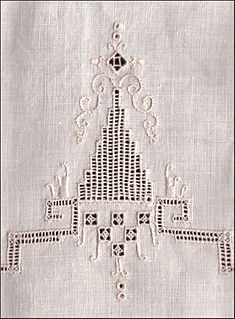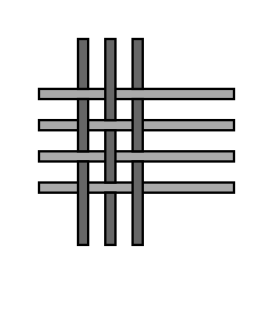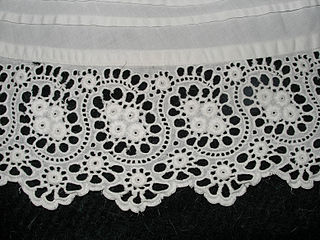It has been suggested that this article be merged with Balanced plain weave . (Discuss) Proposed since March 2019. |

Even-weave fabric or canvas is any woven textile where the warp and weft threads are of the same size.[ citation needed ]
It has been suggested that this article be merged with Balanced plain weave . (Discuss) Proposed since March 2019. |

Even-weave fabric or canvas is any woven textile where the warp and weft threads are of the same size.[ citation needed ]
This section does not cite any sources .(March 2016) (Learn how and when to remove this template message) |
Even-weave fabrics include even-weave aida cloth, linen, and needlepoint canvas. These fabrics are typically required as foundations for counted-thread embroidery styles such as blackwork, cross-stitch, and needlepoint, so that a stitch of the same "count" (that is, crossing the same number of fabric threads) will be the same length whether it crosses warp or weft threads.

Cross-stitch is a form of sewing and a popular form of counted-thread embroidery in which X-shaped stitches in a tiled, raster-like pattern are used to form a picture. The stitcher counts the threads on a piece of evenweave fabric in each direction so that the stitches are of uniform size and appearance. This form of cross-stitch is also called counted cross-stitch in order to distinguish it from other forms of cross-stitch. Sometimes cross-stitch is done on designs printed on the fabric ; the stitcher simply stitches over the printed pattern. Cross-stitch is often executed on easily countable fabric called aida cloth whose weave creates a plainly visible grid of squares with holes for the needle at each corner.

Embroidery is the craft of decorating fabric or other materials using a needle to apply thread or yarn.

Hardanger embroidery or "Hardangersøm" is a form of embroidery traditionally worked with white thread on white even-weave linen or cloth, using counted thread and drawn thread work techniques. It is sometimes called whitework embroidery.

Drawn thread work is a form of counted-thread embroidery based on removing threads from the warp and/or the weft of a piece of even-weave fabric. The remaining threads are grouped or bundled together into a variety of patterns. The more elaborate styles of drawn thread work use a variety of other stitches and techniques, but the drawn thread parts are their most distinctive element. It is also grouped as whitework embroidery because it was traditionally done in white thread on white fabric and is often combined with other whitework techniques.

Berlin wool work is a style of embroidery similar to today's needlepoint. It was typically executed with wool yarn on canvas. It is usually worked in a single stitch, such as cross stitch or tent stitch although Beeton's book of Needlework (1870) describes 15 different stitches for use in Berlin work. It was traditionally stitched in many colours and hues, producing intricate three-dimensional looks by careful shading. The design of such embroidery was made possible by the great progresses made in dyeing in the 1830s, especially by the discovery of aniline dyes which produced bright colors.

Counted-thread embroidery is any embroidery in which the fabric threads are counted by the embroiderer before inserting the needle into the fabric. Evenweave fabric is usually used; it produces a symmetrical image as both warp and weft fabric threads are evenly spaced.

Crewel embroidery, or crewelwork, is a type of surface embroidery using wool. A wide variety of different embroidery stitches are used to follow a design outline applied to the fabric. The technique is at least a thousand years old.
Needlepoint or canvas work is a form of counted thread embroidery in which yarn is stitched through a stiff open weave canvas. Traditionally needlepoint designs completely cover the canvas. Although needlepoint may be worked in a variety of stitches, many needlepoint designs use only a simple tent stitch and rely upon color changes in the yarn to construct the pattern.

Aida cloth is an open, even-weave fabric traditionally used for cross-stitch embroidery. This cotton fabric has a natural mesh that facilitates cross-stitching and enough natural stiffness that the crafter does not need to use an embroidery hoop.

Darning is a sewing technique for repairing holes or worn areas in fabric or knitting using needle and thread alone. It is often done by hand, but it is also possible to darn with a sewing machine. Hand darning employs the darning stitch, a simple running stitch in which the thread is "woven" in rows along the grain of the fabric, with the stitcher reversing direction at the end of each row, and then filling in the framework thus created, as if weaving. Darning is a traditional method for repairing fabric damage or holes that do not run along a seam, and where patching is impractical or would create discomfort for the wearer, such as on the heel of a sock.

Backstitch or back stitch and its variants stem stitch, outline stitch and split stitch are a class of embroidery and sewing stitches in which individual stitches are made backward to the general direction of sewing. In embroidery, these stitches form lines and are most often used to outline shapes and to add fine detail to an embroidered picture. It is also used to embroider lettering. In hand sewing, it is a utility stitch which strongly and permanently attaches two pieces of fabric.
Surface embroidery is any form of embroidery in which the pattern is worked by the use of decorative stitches and laid threads on top of the foundation fabric or canvas rather than through the fabric; it is contrasted with canvas work.

Plain weave is the most basic of three fundamental types of textile weaves. It is strong and hard-wearing, and is used for fashion and furnishing fabrics.
Tent stitch is a small, diagonal needlepoint stitch that crosses over the intersection of one horizontal (weft) and one vertical (warp) thread of needlepoint canvas forming a slanted stitch at a 45-degree angle. It is also known as needlepoint stitch and is one of the most basic and versatile stitches used in needlepoint and other canvas work embroidery. When worked on fine weave canvas over a single warp and weft thread it is known as petit point in contrast to stitches, such as Gobelin, worked over multiple warp and/or weft threads.

A selvage or selvedge is a "self-finished" edge of fabric, keeping it from unraveling and fraying. The term "self-finished" means that the edge does not require additional finishing work, such as hem or bias tape, to prevent fraying.

Parisian stitch is a longer horizontal/vertical stitch used in needlepoint next to a smaller parallel stitch to create a basketweave pattern. The end points on either end alternate in a staggered pattern.
The manufacture of textiles is one of the oldest of human technologies. To make textiles, the first requirement is a source of fibre from which a yarn can be made, primarily by spinning. The yarn is processed by knitting or weaving, which turns yarn into cloth. The machine used for weaving is the loom. For decoration, the process of colouring yarn or the finished material is dyeing. For more information of the various steps, see textile manufacturing.

Cutwork or cut work, also known as punto tagliato in Italian, is a needlework technique in which portions of a textile, typically cotton or linen, are cut away and the resulting "hole" is reinforced and filled with embroidery or needle lace.

Cross stitches in embroidery, needlepoint, and other forms of needlework include a number of related stitches in which the thread is sewn in an x or + shape. Cross stitch has been called "probably the most widely used stitch of all" and is part of the needlework traditions of the Balkans, Middle East, Afghanistan, Colonial America and Victorian England.
Sewing is the craft of fastening or attaching objects using stitches made with needle and thread. Sewing is one of the oldest of the textile arts, arising the in Paleolithic Era. Although usually associated with clothing and household linens, sewing is used in a variety of crafts and industries, including shoemaking, upholstery, sailmaking, bookbinding and the manufacturing of some kinds of sporting goods. Sewing is the fundamental process underlying a variety of textile arts and crafts, including embroidery, tapestry, quilting, appliqué and patchwork.
| Wikimedia Commons has media related to Cross-stitching . |
| Wikimedia Commons has media related to weaving . |
| This article about textiles is a stub. You can help Wikipedia by expanding it. |